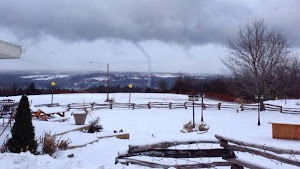When you hear the term waterspout, you may think of places like the Florida Keys or Gulf Coast in summer. If you live around the Great Lakes, you may have seen one in the fall.
But what about the dead of winter in the northern U.S.? It's not just theoretically possible, it actually happened twice this week.
The photo above was taken in the Finger Lakes region of central New York, specifically Cayuga Lake, on the morning of January 21. The morning low temperature in nearby Ithaca, N.Y. was 5 degrees, so it's conceivable temperatures at the time of the photo were no warmer than the single digits or teens.
A second waterspout was photographed on the southern end of Lake Champlain near Essex, N.Y. on the afternoon of January 22.
The daytime high in nearby Burlington, Vt. was two degrees below zero.
Isn't it too cold for this in January? Doesn't it have to be at least somewhat warm and humid?
The key to waterspouts forming is not simply the surface temperature, but the temperature difference between air near the lake surface and air a few thousand feet above the surface.
When deep, cold air spills over relatively warm bodies of water, such as the Great Lakes, Lake Champlain, or Cayuga Lake, the difference between the cold air aloft and the not as cold air near the lake surface leads to instability, namely, air that wants to rise, forming clouds. This is the basic mechanism for lake-effect rain and snow.
If there's enough low-level spin from a weak wind shift boundary over the body of water, the rising air converging from different directions can tighten the rotation into a waterspout.
In both cases from this past week, it appears the waterspouts formed from within a lake-effect snowband.
Of course, for this to occur in mid-winter, you also need a relatively ice-free body of water, otherwise the flux of relatively warm, humid air from the lake, or river won't occur.
Winter waterspouts were also photographed in early January 2012 over the Missouri River in South Dakota. According to photographer Chris Westcott, there were six brief waterspouts at one time during this event.
Most fair-weather, or non-supercell, waterspouts remain over water. Those that do come ashore are usually capable of only minor damage, with maximum wind speeds generally under 70 mph.
It has been estimated between 400 and 500 waterspouts spin near the Florida Keys each year. More

No comments:
Post a Comment